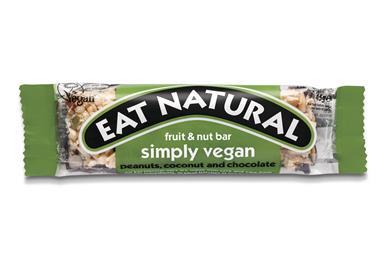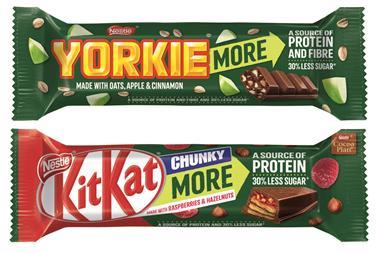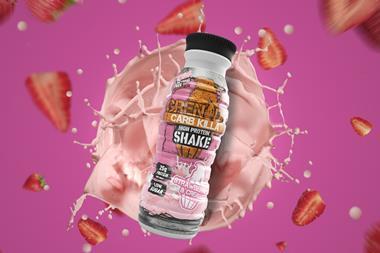Consumer demand for protein products is broadening as today’s shoppers no longer see them as niche products but healthier snacks.

Once the preserve of muscle-bound gym types, protein products have become the go-to snack for a wide cross-section of society. “Research shows that about 40% of the population are actively looking to lead a healthier lifestyle by taking more time to exercise and turning to protein-rich snacks to help fuel their exercise and working day,” claims Natural Balance Foods marketing director Marina Love-Smith, citing Kantar Media TGI 2017.
Its Trek brand saw sales grow 24% year on year (IRI Retail Data w/e 8 December 2018) and its best-performing range, Protein Flapjacks, has seen growth of 35% in convenience (52 w/e 8 December 2018).
Indeed, the protein bar market is currently worth £51m and is rapidly growing to keep up with the changing needs of consumers (Nielsen epos sales MAT 2 December 2017). “The market is increasing by 54% year on year, driven by changing lifestyles and tastes, as consumers look for ways to boost energy while balancing their diet,” states Susan Nash, trade communications manager at Mondelez International. Last summer the company launched Boost+ Protein, which contains 12g of protein via protein crisps – four times more protein and 32% less sugar than the standard Boost bar.
Weetabix concurs that protein product consumption is on the rise. “Protein is well and truly on its way to becoming mainstream,” says Weetabix Protein brand manager Jane Richards. “Key to the growth is the shift in appeal from gym bunnies wanting to build muscle and aid recovery, to a broader, mainstream audience. This is due to the health attributes and benefits consumers now associate with protein.”
The Weetabix Protein brand is worth £5m and the firm claims that last year’s Weetabix Protein Choc Chip launch is providing the highest return on sales of all protein skus launched in 2018.
Bulk Powders, maker of Macro Munch protein bars – which each boast 20g of protein – notes that the age of protein product consumers has broadened. “From a statistical perspective, the age and demographic has historically been on the younger and more affluent side (due to higher cost and the products having been marketed to young gym-goers interested in sports),” says retail account manager Robert Harley. “However, as protein has become increasingly mainstream, the distribution of brands has increased in some cases to being available almost universally. Then there are the number of options of format available, which has proliferated massively.”
Budgens Ashford Service Station, one of four stores in Kent owned by Suresh Arulananthan, sells protein products to a broad range of customers. “Some people buy it on the way to work – building sites and network rail – so it isn’t just people going to the gym,” Suresh says. “It tends to be younger people who buy them, aged 20-30, but there are some middle-aged people buying into it, too.”
Amish Shingadia, who owns Budgens Southwater and Londis Caterways in West Sussex with father Ramesh, mother Nim and brother Alpesh, agrees that protein lines appeal to many. “People come in for their lunch break or a snack and they’ll grab a coffee and a protein bar. It’s a mixed customer base – students, builders, mums,” he says.
Grenade founder Juliet Barratt has certainly found this to be the case. “In as little as a year we’ve seen the needs of the shopper change substantially. For example, the key reason to purchase protein bars now is as a snack between meals, usually as an alternative to chocolate. Muscle toning and sports usage are still important factors, but the category is now being driven by informed, mainstream shoppers looking for a healthier, more balanced alternative to traditional snacks.”
Grenade grew by 145% within the convenience channel in 2018, and drove 69% of all value growth within total protein bars, claims the firm.
Buttering up protein fans
High protein peanut butter Hi-Pro has received a packaging revamp to communicate its high protein content more clearly.
‘‘Hi-Pro was originally launched to appeal to keen sportspeople looking to boost their protein intake, however our high protein peanut butter now generates huge interest from people who are generally active and becoming interested in their health and wellbeing as the benefits of a high protein diet have become more prevalent,” says Richard Duerr, sales and marketing director at manufacturer Duerr & Sons.
“With an overwhelming amount of high protein products on-shelf, it’s important to make it easy for consumers to select the right product for them.”
The company claims Hi-Pro contains the highest percentage of protein from peanuts alone (33%) compared with other high protein peanut butter brands – a message now clearly visible on the jar.
“Additionally, its clean product qualities are communicated – no palm oil, no salt, no sugar and no whey. The product is also suitable for vegetarians and vegans, and available in two variants: crunchy and smooth,” says Duerr.
He adds: “Consumer interest in protein shows no signs of slowing, so the redesign will be supported by a sampling and influencer marketing campaign, educating shoppers on how the product can be used and its benefits.”
James Brundle, co-founder of Eat 17, which comprises four stores in London and Bishop’s Stortford, Hertfordshire, has witnessed strong sales of protein products across all his stores. The group stocks Grenade, Kind and Fulfil protein bars, as well as powders from Amazing Grass, Navitas, Plantforce and Naturya.
“We don’t have a dedicated fixture, but they are performing well. I think everyone is buying into protein and it seems to be an area that is getting busier,” says James. “We’re giving more space to powders and bars.”
Jeeta Bhadal, who owns a One Stop and Londis in Leeds with brothers Peter and Raj, claims that sales of protein products are growing at a steady pace. “In the Londis store we have Mars and Yorkie protein bars, Grenade bars, Eat Natural bars and Trek bars.
“In the One Stop store we are more limited in range, but we have protein bars by the coffee machine and Graze packs on the counter.”
There’s no doubt in his mind as to the top seller. “The Grenade Bars are the best-sellers – everybody in the gyms use them. We have about six different flavours.”
The Grenade brand is also a big hit for Jay Patel, manager at Simply Fresh St James News in Westminster, London. “We have a separate bay for protein bars. Grenade is our best-seller; we sell five or six cases a week.”
He likes to experiment with different protein bar brands and regularly stocks new lines. “We’ve got Clif bars, PHD bars, and now there’s a Kind bar, but none have the same number of flavours as Grenade.”
He also claims that protein drinks are popular. “We sell Grenade shakes, three flavours of Arla Protein Yogurt, and a chocolate milk drink.”
Protein bars and shakes are often purchased at Budgens Ashford Service Station. “We sell quite a lot of protein products because it’s a forecourt. Fuel customers want morning energy products, so they tend to go for those,” says Suresh.
“We have a full bay of protein products with shakes and bars. Grenade products are our best-sellers and Happy Shopper products do well, too.”
However, he claims that sales have dropped recently. “I’m not sure if it’s slowed down because of price or taste. Perhaps it will pick up in the summer when people start going out to exercise.”
Ramesh Shingadia reports disappointing protein sales at Budgens Southwater. “It has plateaued,” he says. “I wouldn’t say it was in decline, but I think it was a fad.”
He reduced the space and range of protein products as part of a range review carried out when the store moved from Londis to Budgens. Nevertheless, the store continues to stock a core range, with Grenade shakes and bars still earning their shelfspace.
“A lot of the time we’ll put protein products in other categories, rather than in their own section. The shakes are in the chillers with other breakfast products, whereas before they made up part of a 1.5 metre protein bay.”
Amish, who runs the family’s Caterways store, has also reduced the protein range. “My store had a fixture for protein but we’ve now implemented it into the fixtures. We did have a protein shelf in the soft drinks chiller, but half of it didn’t ship. I think consumers have picked up that it isn’t as healthy as it seems. Some 95% of our protein products are single-sited now.”
Amish believes that the relatively high price has put consumers off. “There would occasionally be promotions on more expensive lines and they’d sell well, a couple of cases a week. Then as soon as it’s off promotion it just sits there, so you know then that price is a barrier.”
He notes that pricemarked protein lines are performing well for this reason. “The Euroshopper protein drink is pricemarked at 89p and has 21g of protein. It performs really well, and the Weetabix protein drink is pricemarked at £1.50 and that’s selling very well now.”
Amish’s theory regarding price is supported by the HIM Healthy Snacking Report 2018. The study found that 55% of shoppers are buying more healthy snacks rather than unhealthy options. However, price was found to be the biggest barrier to eating healthier options, with 46% of shoppers saying healthy snacks are too expensive.
In spite of his concerns regarding pricing, Amish is confident that there is an opportunity to grow protein sales within convenience. “There’s definitely an opportunity, but the price needs to be better for consumers and bars need to shout that they’re healthier,” he says.
One manufacturer that has taken this on board is Mars Wrigley Confectionery. New Mars More Protein contains 17.5g of sugar per bar, which is 40% less than the original, while Snickers More Protein contains 14.1g per bar, which is 30% less. What’s more, products brandish bright blue flashes highlighting the increased protein and reduced sugar content.
“When people hear that protein chocolate bars have less sugar it will make a difference to sales as people still want to indulge, but they are health conscious,” says Jeeta.
He is confident that the protein trend is more than just a flash in the pan. “I can only see it going upwards,” he says.
James agrees: “I think it will continue growing. I think interest in protein will continue.”
Ramesh is more cautious: “There might be a debate about whether we have the right demographics, the population is quite elderly, so maybe the demand isn’t there, whereas other retailers might have a much younger population that may have demand for it.”
However, Ryvita senior brand manager Mia Hartwell claims that protein products can appeal to older consumers. “The draw of protein products is also no longer limited to a younger demographic, with many protein brands now also over-indexing with 55+ audiences,” she says.
“The protein trend is here to stay, marking the beginning of a trend where consumers are looking more for products that have ‘added extra goodness’ due to their potential health benefits.”
Love-Smith needs no convincing protein will remain a strong category over the coming years. “Protein is such an essential nutritional ingredient that shoppers are unlikely to lose their appetite for it,” she says.
Harley is equally positive. “We are no way near saturation point and consumers continue to try new brands, products and formats,” he says. “If protein were a trend still specific to sports nutrition then I could see it having a boom and bust as something new comes along to help sporty people achieve that extra 1%. But protein is no longer limited in this way, and it has become increasingly normal for people of all ages, from all geographic regions and with any level of affluence, to buy protein products.”
Merchandising: Take a mission-led approach to add sales
When it comes to helping consumers navigate protein products, Grenade founder Juliet Barratt advises c-stores to take a mission-led approach to merchandising.
“The first step is to merchandise by occasion, rather than by product type – think about why the shopper is buying the product,” she says. “Then have clear segment blocking. Health is a clear overall trend, but can be subjective in nature. Therefore, having merchandising that clearly delineates between ‘Everyday Treats’, and ‘Naturally Nutritional’ products is a good start to making fixtures clearer.
“Finally, consider the role of POS. Use shelf-edge stripping, shelf-barkers and bus stop signage to separate these areas and guide shoppers.”
Andy Boucher, convenience and discounters category manager at Arla Foods UK, agrees that POS has an important role to play in making protein products stand out on shelf.
“At Arla we have found that bus stop barkers and shelf strips are the best options for the convenience channels capitalising from on-the-go sales opportunities, from those looking for a snack option or as part of a pre-/post- exercise routine,” he says.
“Meeting these on-the-go needs by stocking products in pouches or with a spoon included further prompts sales, making it convenient for the consumer.
“Retailers should consider shelf trays for product standout, clip strips to site pouch packs at key on-the-go areas and ElastiTags on certain skus to help upsell a wider range of products.”
































No comments yet